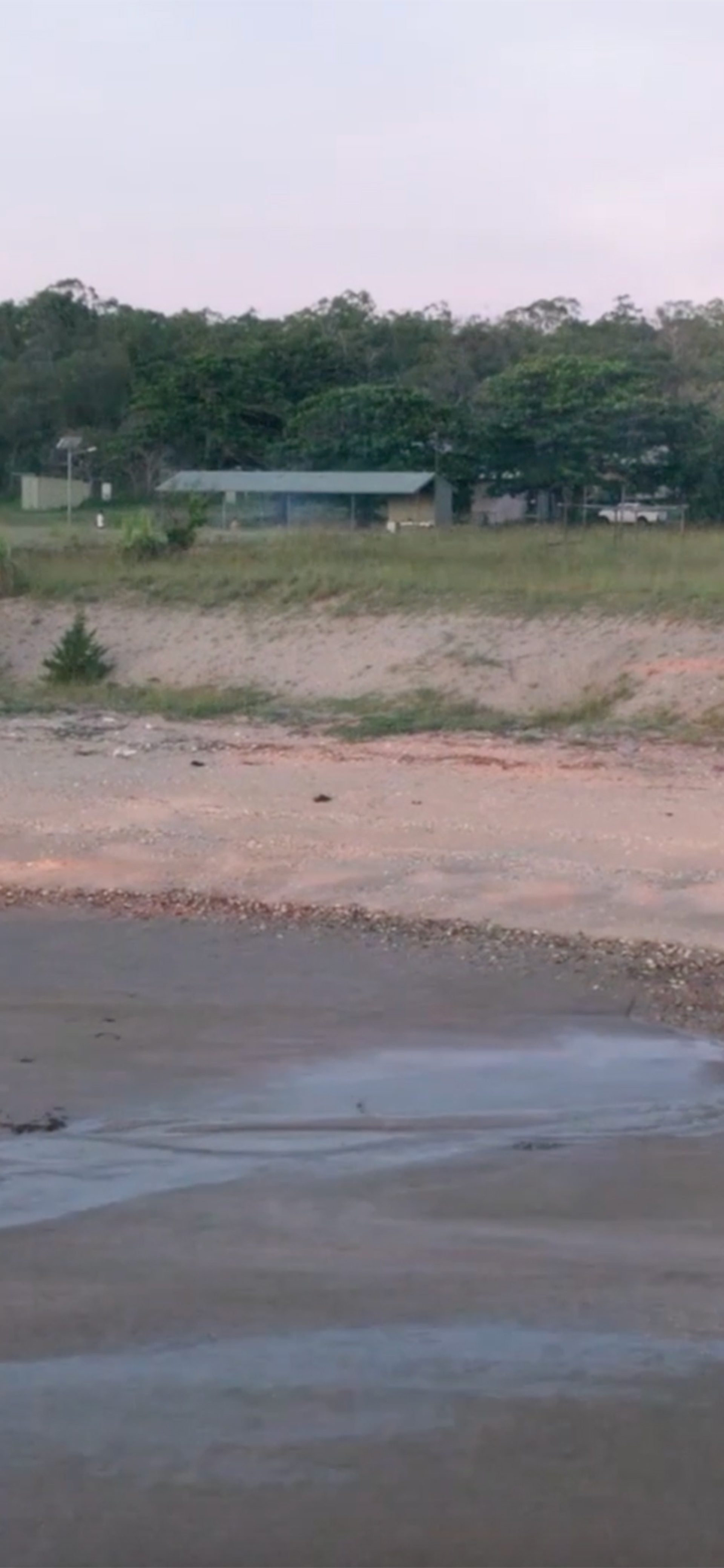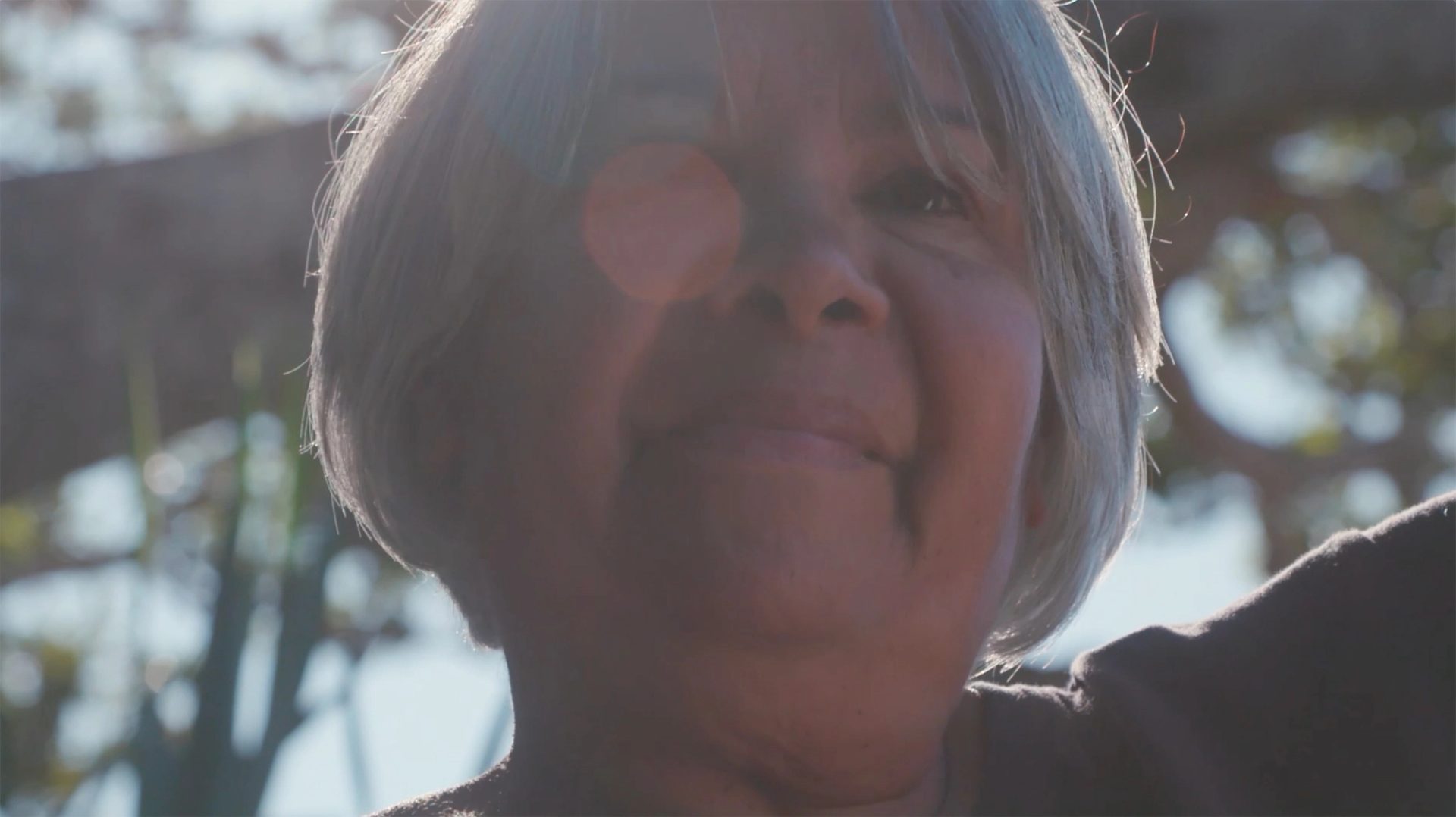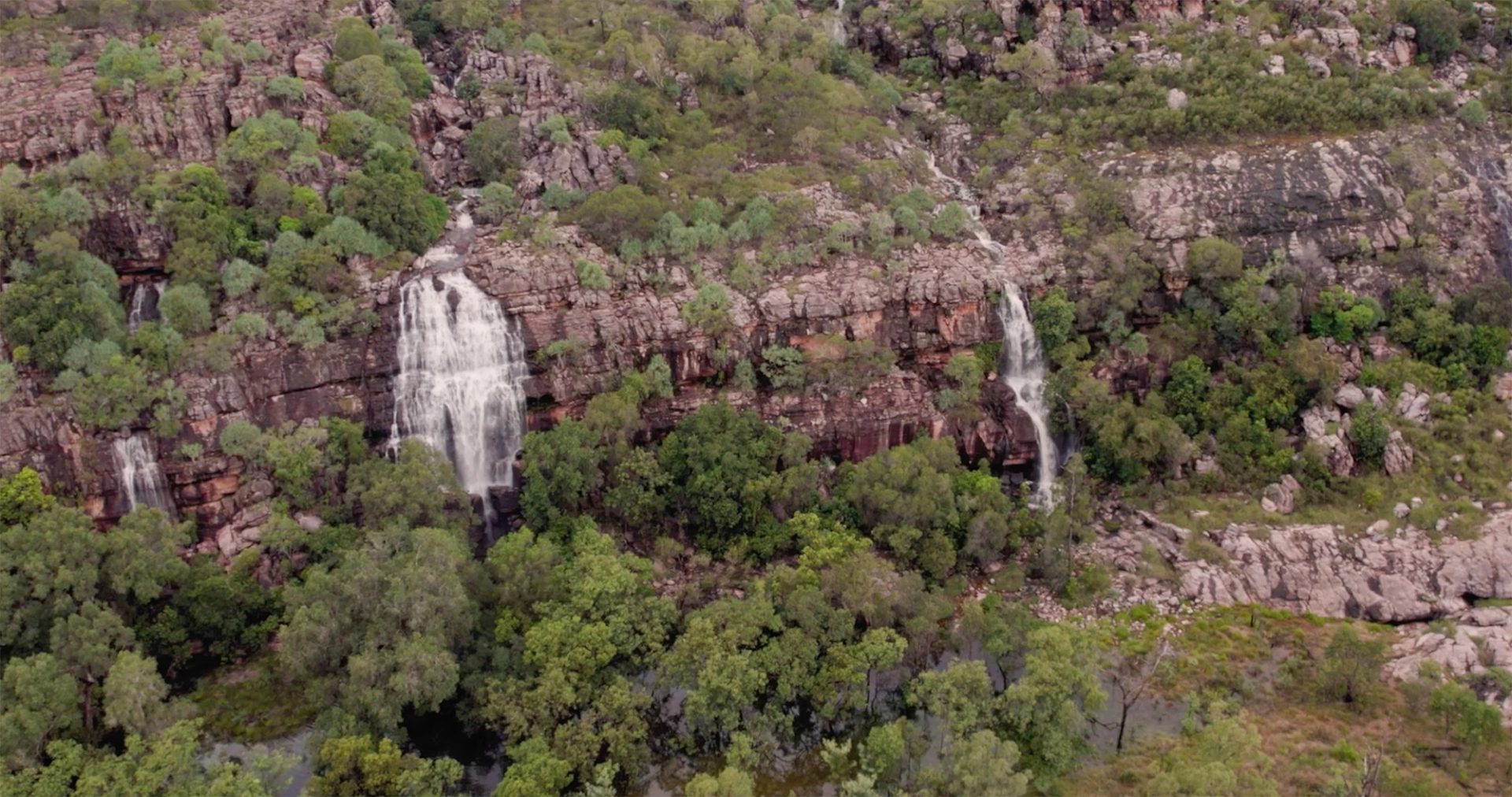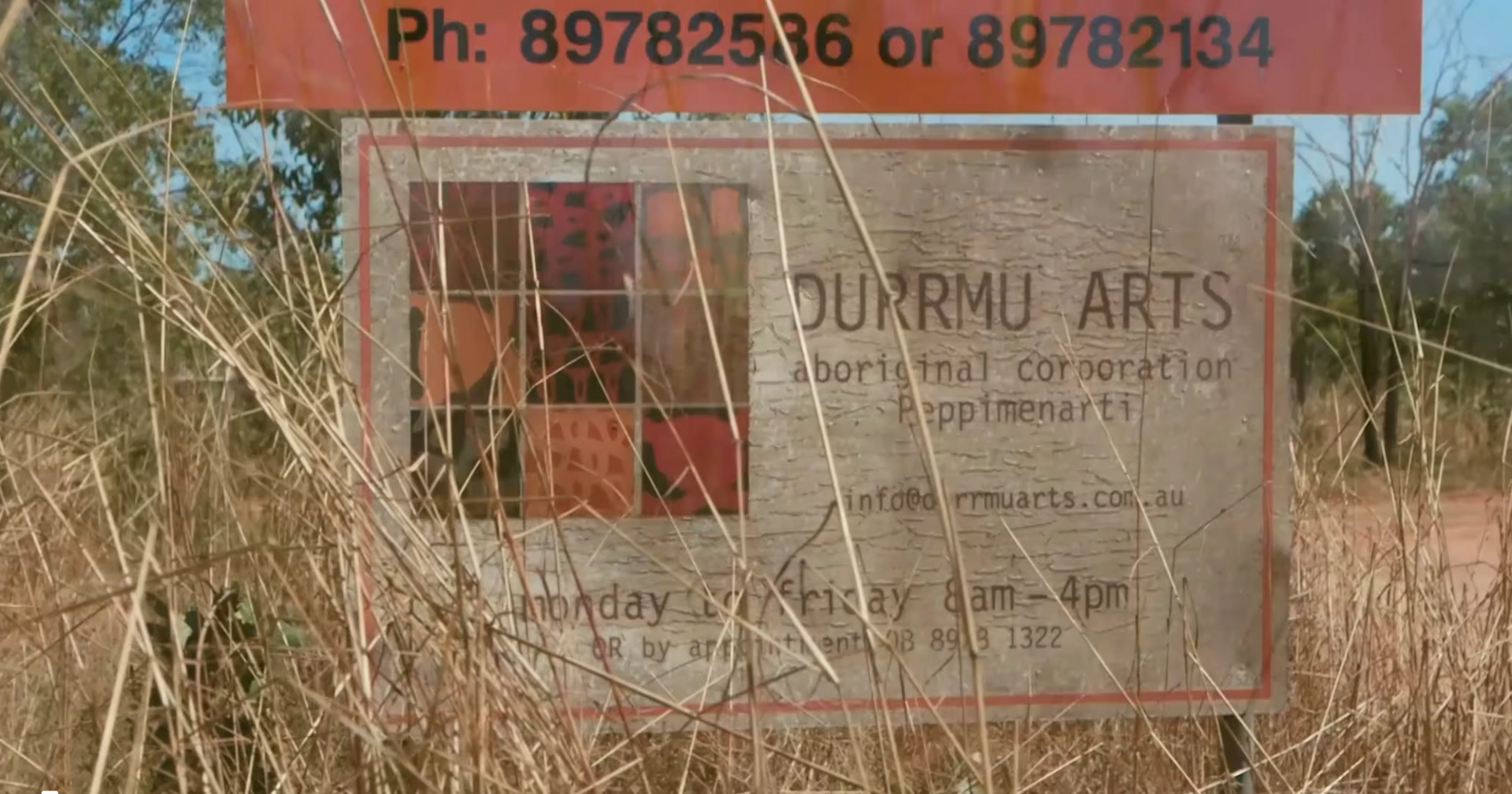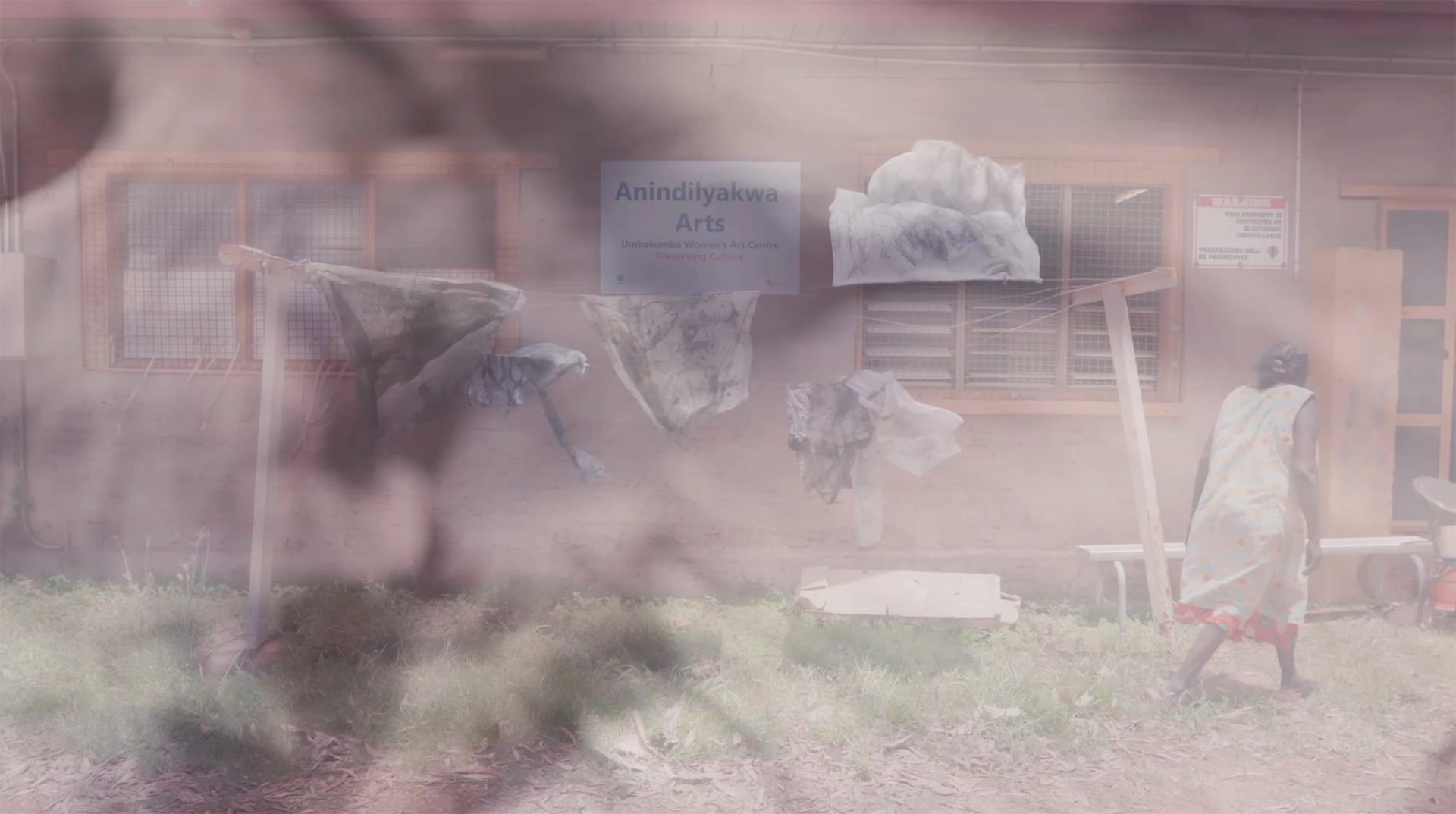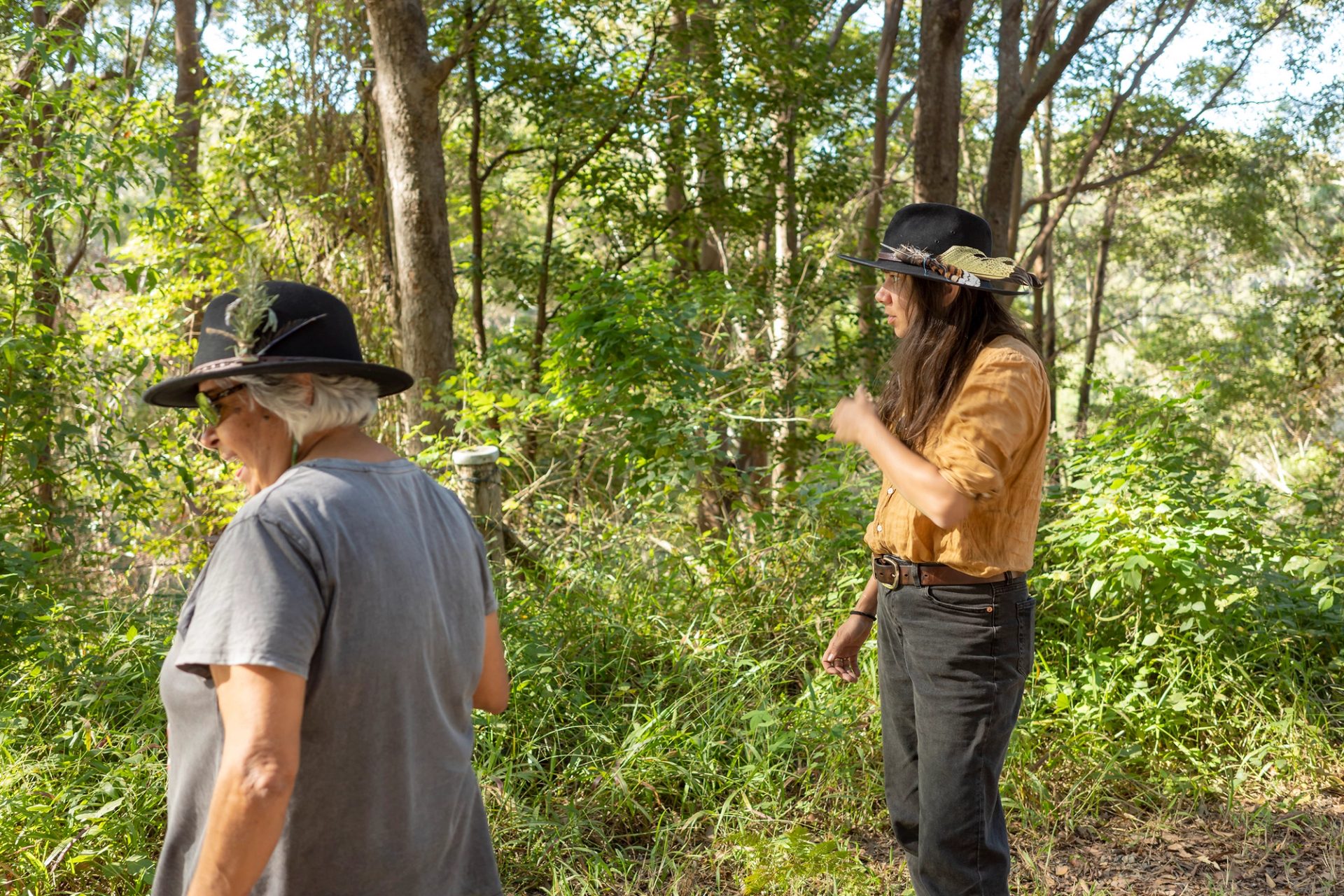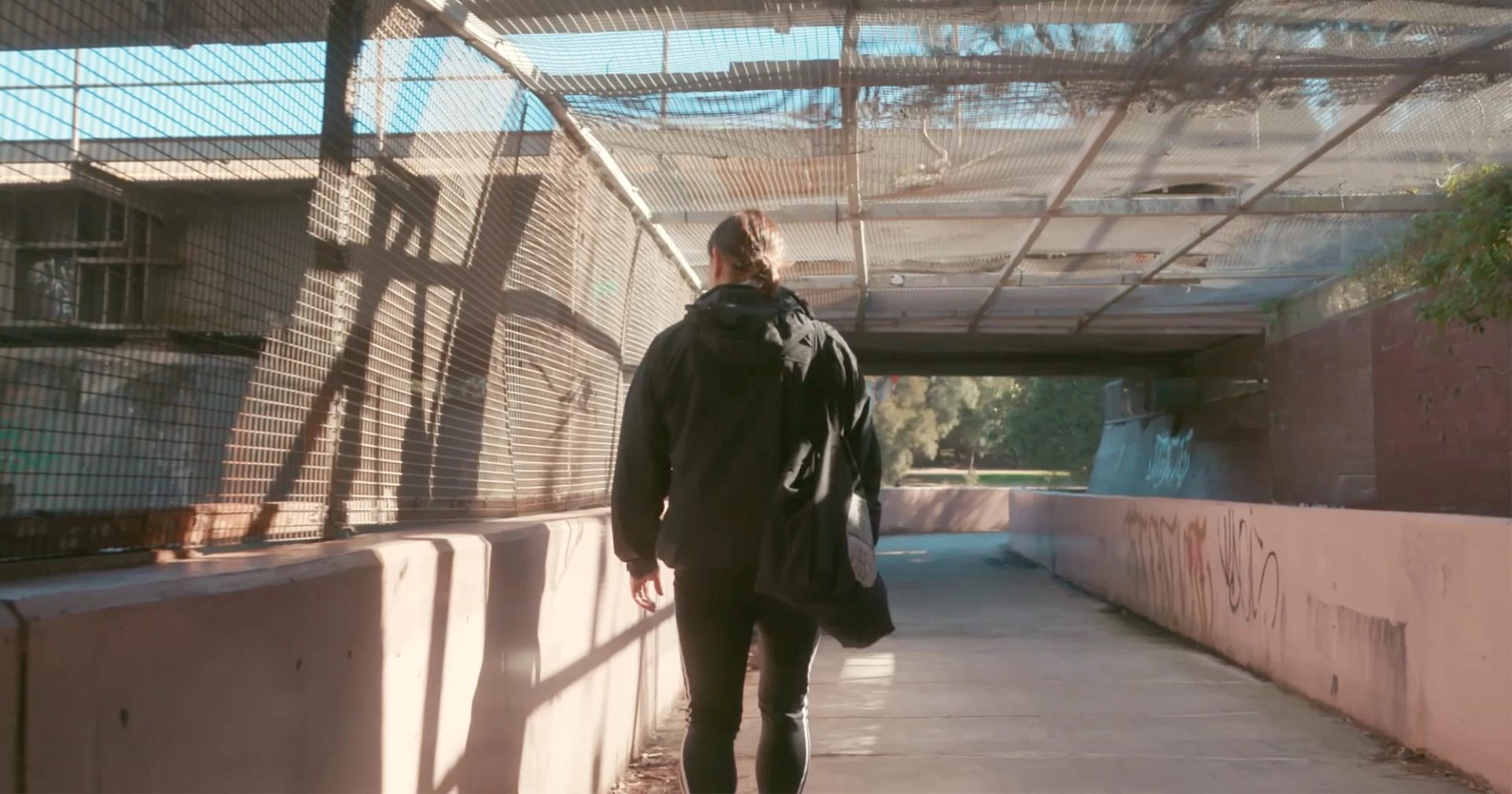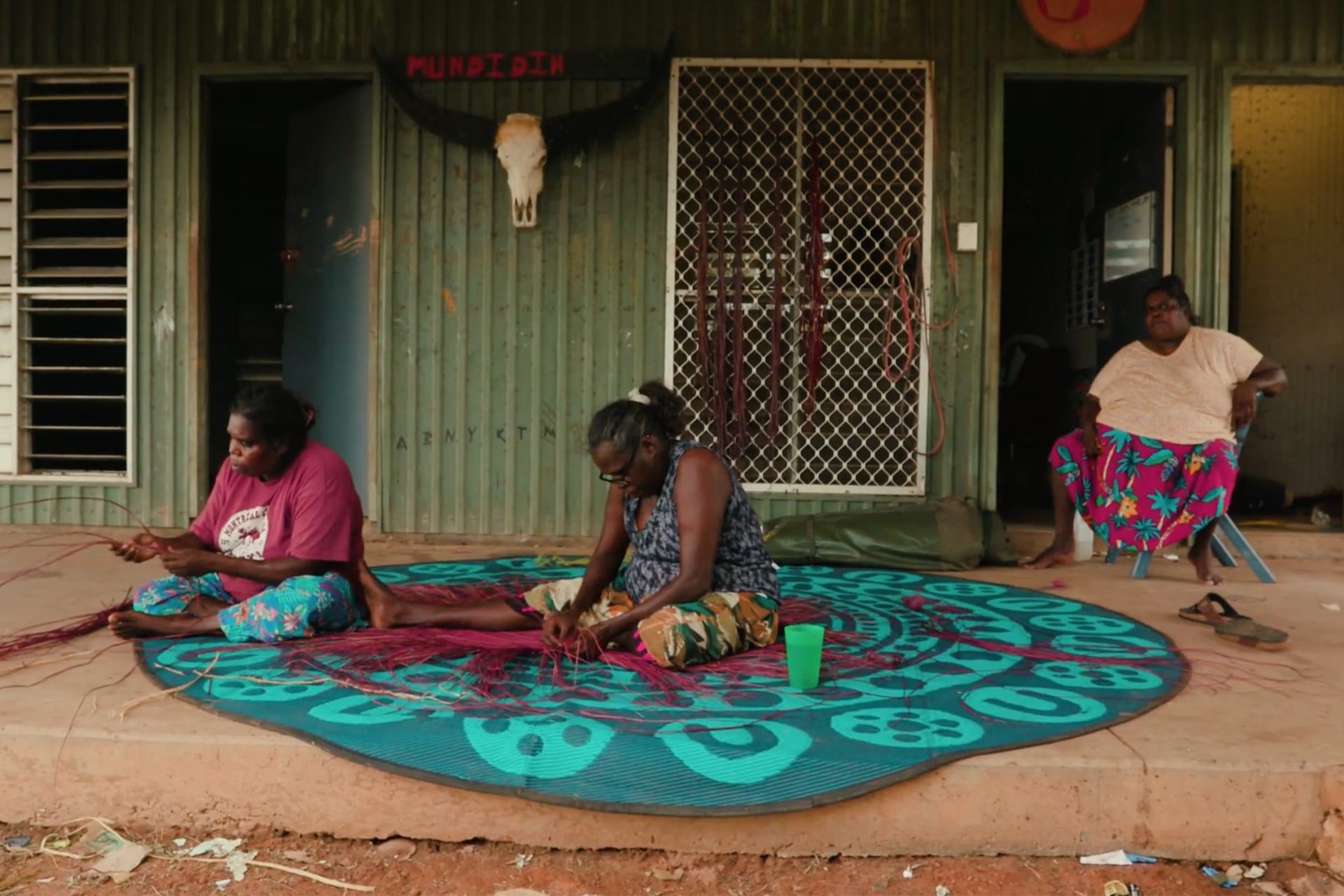Milingimbi Art and Culture Centre

Curator Coby Edgar reflects on her travels to Laŋarra with videographer Tim Hillier and Miriam La Rosa from Agency. In this story Coby writes about the time spent with Milingimbi artists in preparation for Alchemy.
Sydney to Melbourne. Melbourne to Darwin for me. Melbourne to Adelaide. Adelaide to Darwin for videographer Tim Hillier and Miriam La Rosa from Agency.
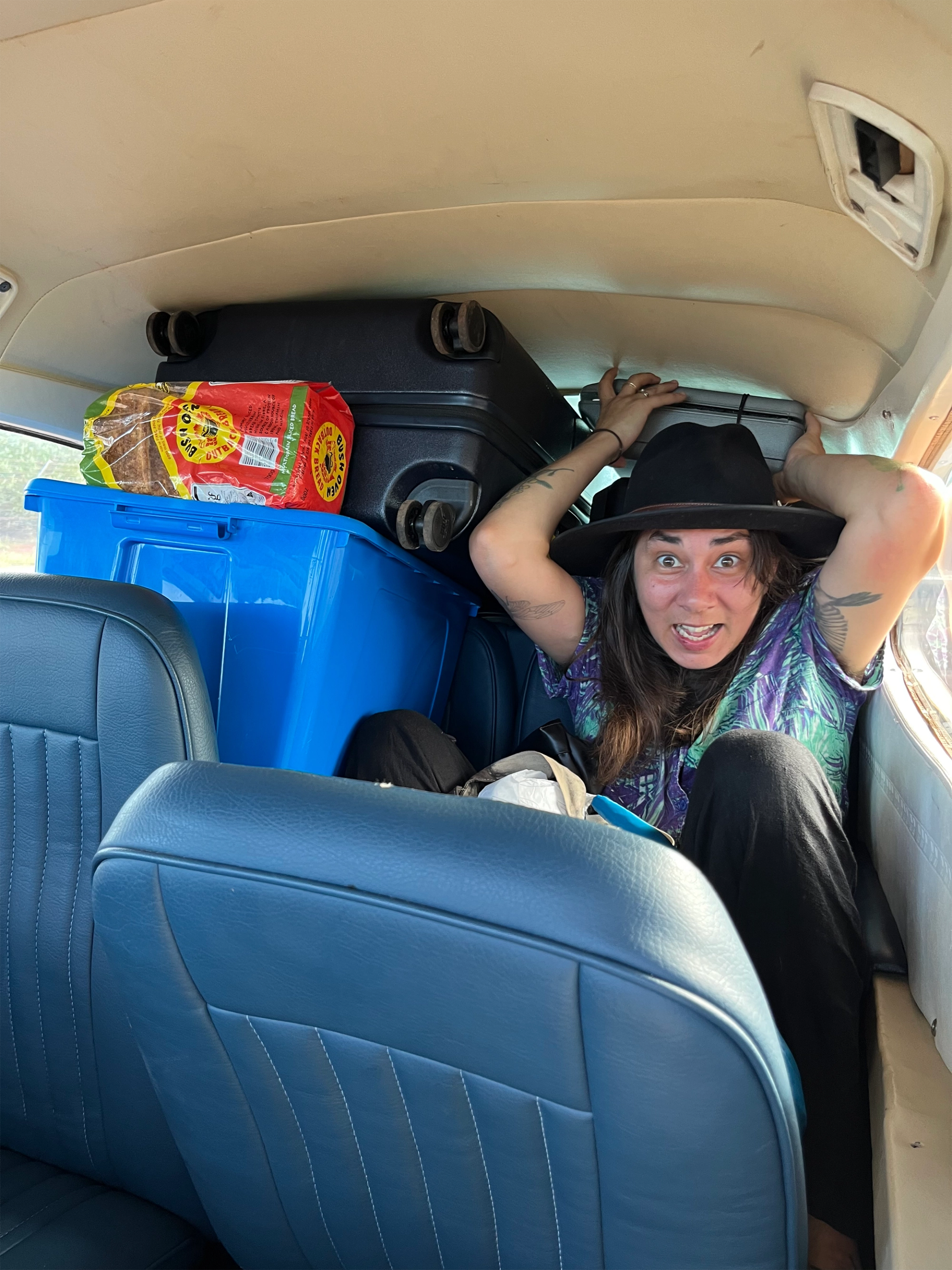
I met up with the team after both parties had travelled for more than 10 hours. The famous redeye to Darwin. I had a toddler behind me who kicked the back of my chair the whole flight. It was 1.30am by the time we got our room keys. I hadn’t eaten dinner as I’d had to run to catch my connecting flight – there’d been no time to stop for a feed. Three hours sleep at the airport hotel in Darwin – next to the bottle shop where a young man had been stabbed the night before for refusing service to hostile customers. The crime scene tape was still strung around the outside of the shop. Flowers stacked up next to the front door, the plastic sleeves rustled in the soft warm wind. The cemetery behind the accommodation is where some of my family members have been laid to rest. Hello Ancestors.
At 7am my father delivered me vital camping gear and much-appreciated coffee and ham and cheese toasted sandwiches. We ate them out the front of the hotel, sitting in the ute tray. My legs swinging and hitting the tow bar.
The charter plane isn’t in the normal airport, it's off to the side. The pilots never look a day older than 30. Ever. Most young pilots come up this way and charter small planes to communities all over the NT to get their hours and experience up. Our pilot had a moustache, aviators and a crisp white shirt. He weighed us and our gear. I clocked in at 65 kg. Mandi King, Milingimbi’s art centre manager, met us and joined the flight back to Yurrwi (Milingimbi Island). She had just got back from a break and jumped straight into Alchemy with us. The plane was a six-seater, pilot included, single engine. With all the gear stacked up there were now five seats. Someone needed to squish in the back with the luggage. I was probably the smallest of the women in the party and not scared of planes like this even though I know I should be, so I offered. Sweating in between a tiny window and a pile of heavy luggage that fell onto me every time Miriam shuffled a little.
The tiny plane wove through cumulonimbus gaps. These planes are loud and bumpy through turbulence. They aren’t friends with big clouds. Yurrwi, off the coast of Arnhem Land, was our next stop. On landing we were picked up in the art centre ute and taken to our accommodation to offload our gear before heading to the art centre.
Helen Ganalmirriwuy Garrawurra met us at the art centre but was feeling a bit sick. I sat with her and Ruth Nalmakarra. Ruth showed me her weavings, she hadn’t been weaving much but started up again recently. Her works are perfection. Subtle but even tones, tight. I spent some time with Helen and talked about the works she is making with Margaret Rarru Garrawurra, and Mandy Batjula Gaykamangu’s work for Alchemy. Helen was on standby with her boat to ferry us over to Laŋarra (Howard Island) the next day if we couldn’t land the plane. She was planning to head over to the island with some supplies for her family but would wait to see if we could land before setting off. The weather had been all over the place and a cyclone had formed over in WA. The landing strip on Laŋarra is dirt. Some of it had washed away. If we couldn’t land the plane, we’d have to fly back to Yurrwi to assess the tides and timing. If we went out on the tinny it would take at least three hours to get to our destination. Not ideal with all of Tim’s tech gear but it’s the only other mode of transport available. Fingers crossed the plane could land.
There is no shop on Laŋarra. So we packed food for the two days. Minimal amounts to keep the weight down on the plane. Mandi received a text from Mandy on Laŋarra – it was a pic of her arms full of newly finished and almost finished works. What a tease!
The next morning Helen was sick. Her cough had worsened in the night. Not ideal to have a sick skipper out on the water. Our plan B was slipping off the options list. We set off in the plane to attempt plan A. The flight was shorter this time. Our young gun pilot surveyed the area, flew low to check the condition of the landing strip and circled back again. The houses are right next to the landing strip – the Laŋarra artists Rarru and Mandy were just below us. It had taken 12 hours to get to Darwin, two hours to Yurrwi and 30 mins to Laŋarra. If the landing strip was not in good enough condition we would not get to meet Rarru and Mandy. We would not get to meet them where they live and work, film any content or see the works they are currently working on for the exhibition. There wouldn’t have been enough time for them to get to Yurrwi either. Rarru is in her 80s. It’s not a trip I would want her to take, I am sure she would rightly refuse to make the trip if asked. Tension was high in my body. Not many people go out there to see Rarru where she lives. The journey is not easy, comfortable or cheap. There is always a risk you won't be able to make it there. Always.
The wheels of the plane came down and I realised I had been tensing my entire body the whole flight. Relief. The pilot was going to land. The risk had paid off.
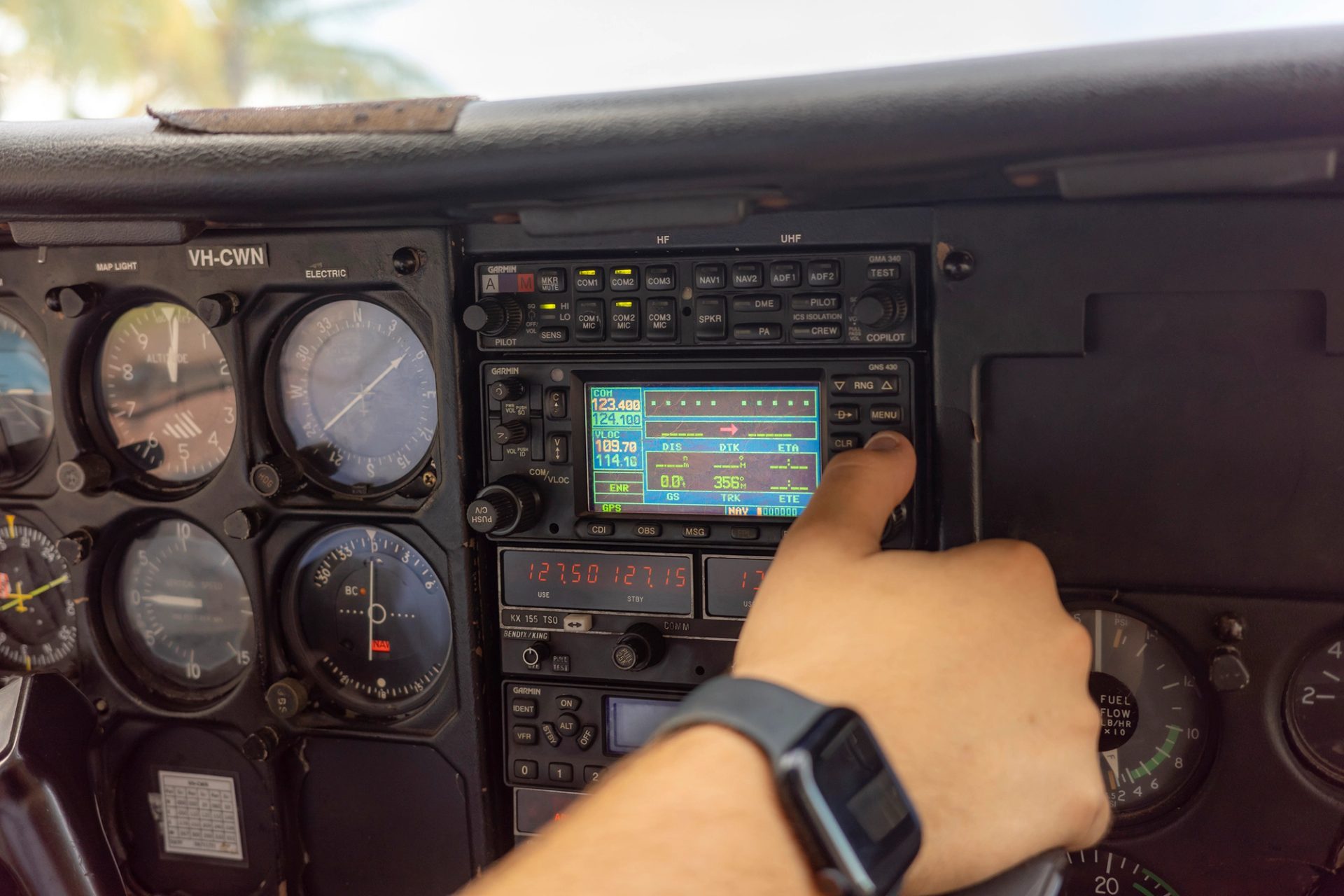
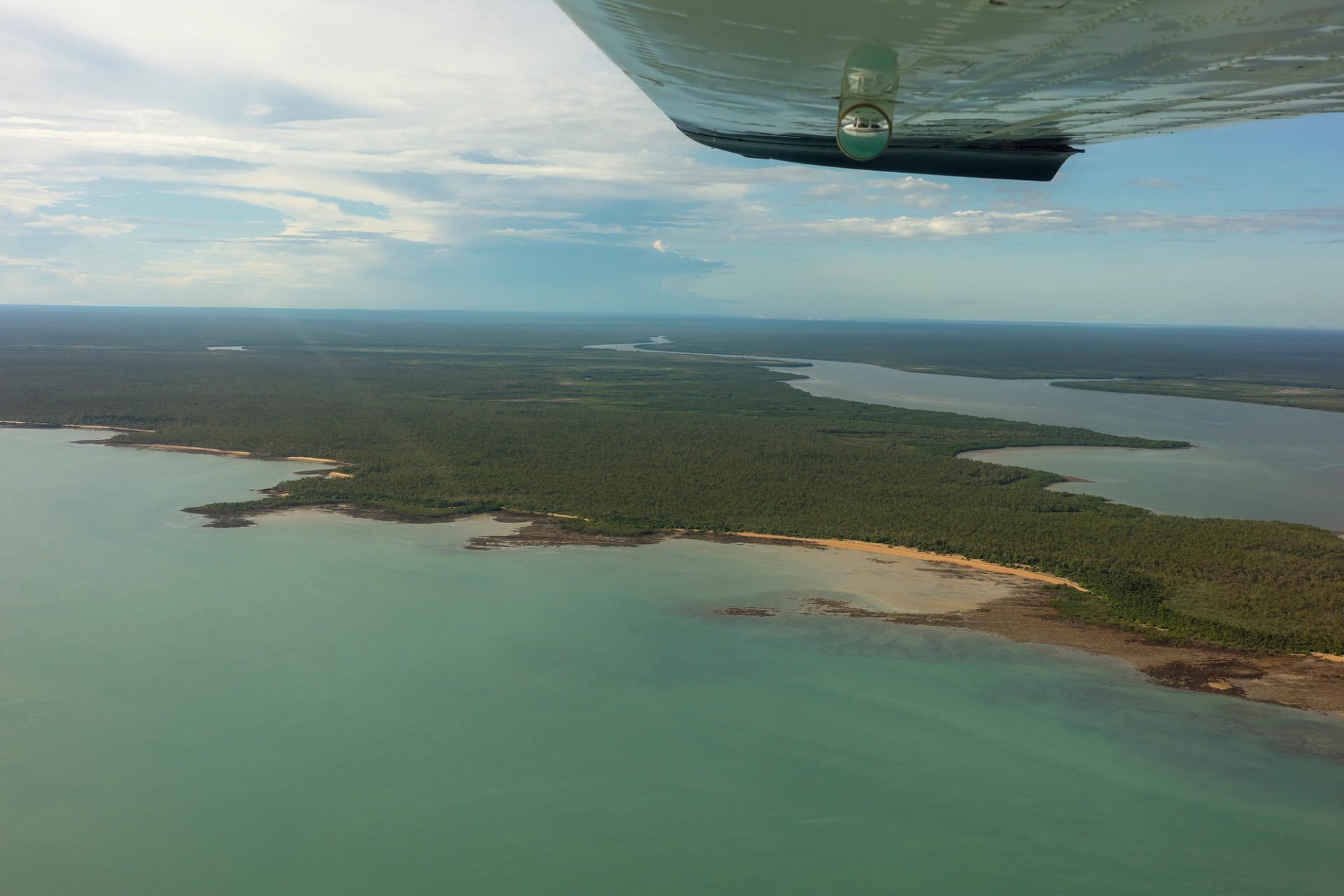

‘This is mol (black) djinbakara. We used to carry them to the swamp after the floods to get the marraräkay (water lilies). We would dig deep into the mud to get the räkay (the edible bulbs), then lay the djinbakara flat and wash them clean on top of it. After they had dried in the sun a while we could take them home to cook and share.’
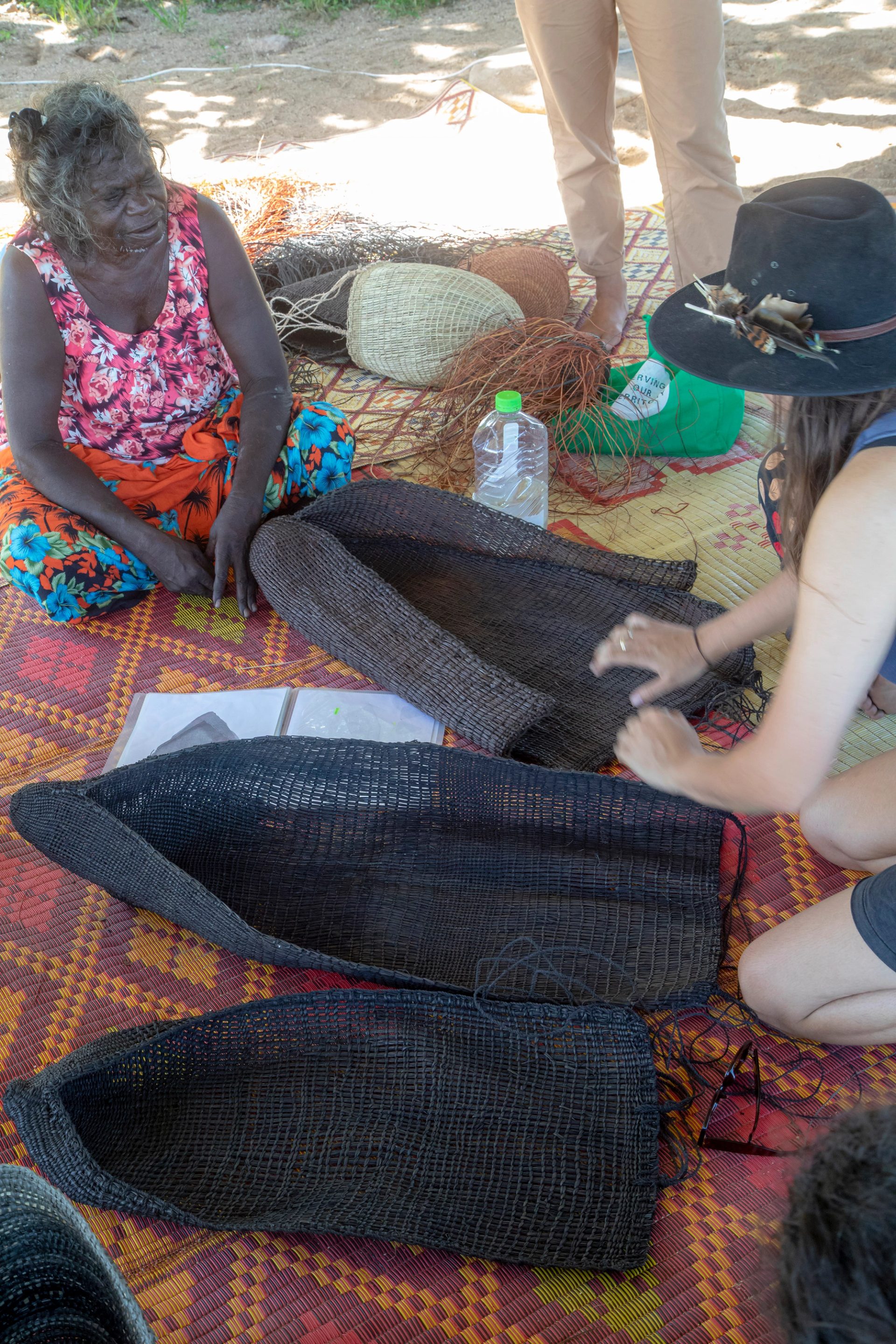
We unloaded onto the dusty landing strip and our plane took off. It would be back to pick us up. If there wasn’t any rain in the next two days to wash away the landing strip.
Minutes later two women appeared from the bush, smiling wide and waving excitedly. One had a wheelbarrow. Our luggage transport. It was Mandy and Elizabeth who had come to help us carry our things to their small community on the beach. Elizabeth grabbed one of the plastic containers full of food and utensils and effortlessly threw it onto her head. We walked together ahead of the wheelbarrow crew. Elizabeth is deaf and spoke to me in sign, directing me down the dirt roads. Thankfully, it was a short walk to the site. She’s a slight woman with a beaming smile, her hair in a bun and a jawline to be envied.
Tired from days of travel we dumped our things in the corner of a large open shed and I spotted gold. Sitting on a mat in the middle of the shed was a bounty of beautiful things. All in red, black, yellow and untreated fibres. This was what we had come for. The trip was already worth it. Rarru, Mandy and Helen had clearly been busy. They had finished all but one of the works for Alchemy already, the first works I had seen completed for this project, what a treat! Mol djinbakara, miṉḏirr (conical basket), mol miṉḏirr (black conical basket), gay'wu (string bag), mol gay'wu (black string bag) and ganybu (hinged fishnet). All but the ganybu laid on the mat. There aren’t many things in this world that can make me feel bubbly, nervous and flustered in an instant but a sight like that does. I walked straight up to the works and shoved my nose into them, ran my hands over the fibres. Rarru laughed at my excitement and talked me through each object.
Mol djinbakara is not an item I have ever seen. It is long and conical but only sewn up at the bottom a little bit. It’s foldable with a handle. Worn on the body with the handle around my shoulder, it reaches below my knee.
Rarru showed me her work, Helen’s work and Mandy’s work. Mandi, the art centre manager, sat with me and we discussed the subtle differences in each woman’s work. Tiny clues they leave in their works. Rarru is the master for a reason. Her weaves were evenly spaced, with rectangular spacing between the horizontal weave lines. She maintained this to the edges then doubled up her lines to create stability in the form. Her edging is similar in appearance to a blanket stitch, with a switch of materials to bush string. Rarru’s sewn up bottom had the most even curvature of the women’s work. Helen didn’t change up material for this one, her edging is made out of pandanus like the body of the work. This choice made her edges more defined as the pandanus doesn’t curve like the string does. Helen’s work has movement. Her spacing changed from even to tight, back to even again for a few dozen lines and then suddenly the stitch gets progressively tight until it reaches a density similar to the mindirr. Mandy’s work was not as even, her lines make squares and her lines aren’t as straight as Helen and Rarru’s. It just tells me she is younger.
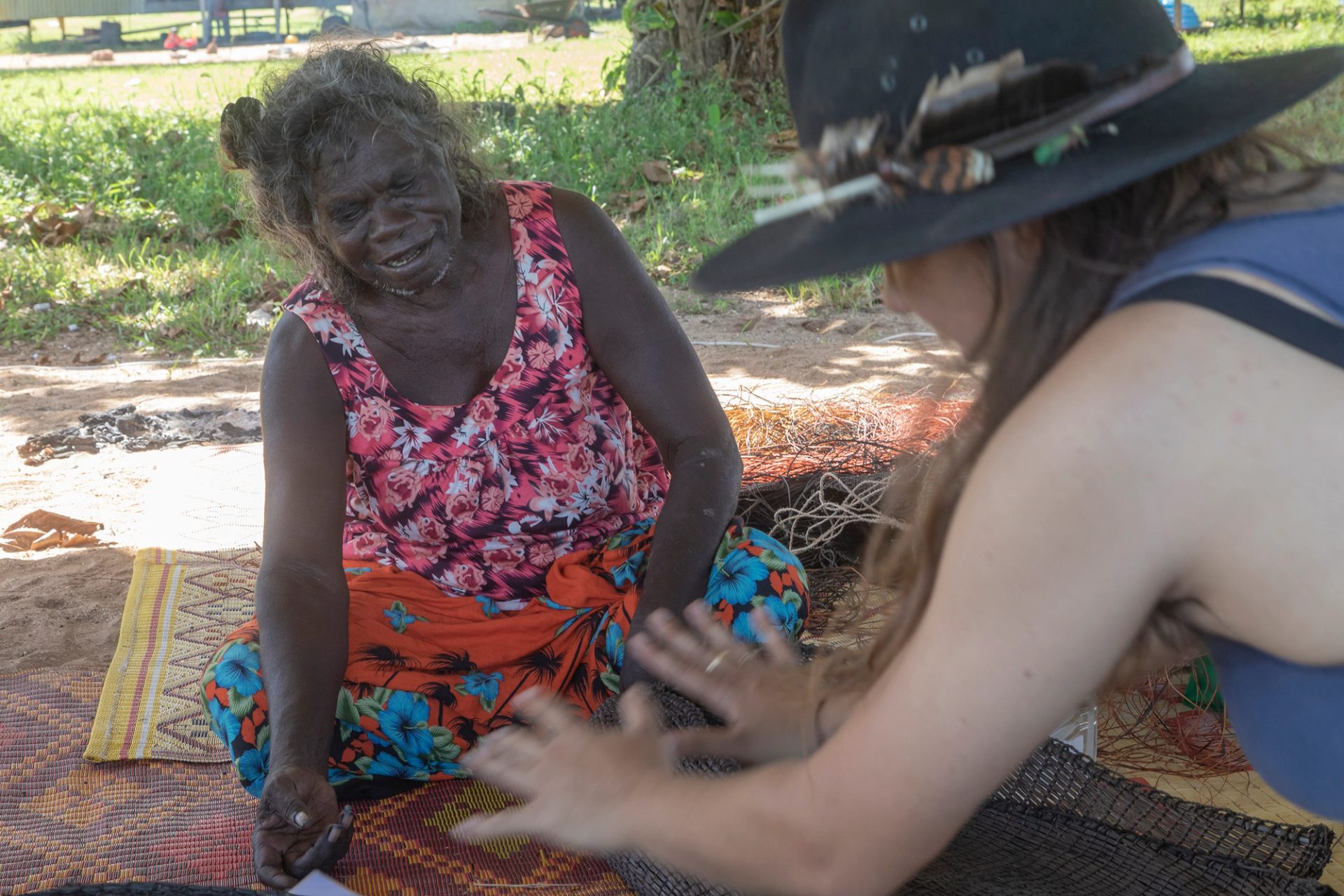

Rarru and Helen’s bodies would have changed over time. Weavers’ bodies show signs. Thicker areas on the hands and, for those who roll string, thicker areas on their knees and inner thigh. Mandy’s body is well on its way. When her body and the material work out how to live with each other over time, the rest will become muscle memory and she won’t need to think about her spacing. All this commentary from me, someone who can’t roll a metre of string and keep it even.
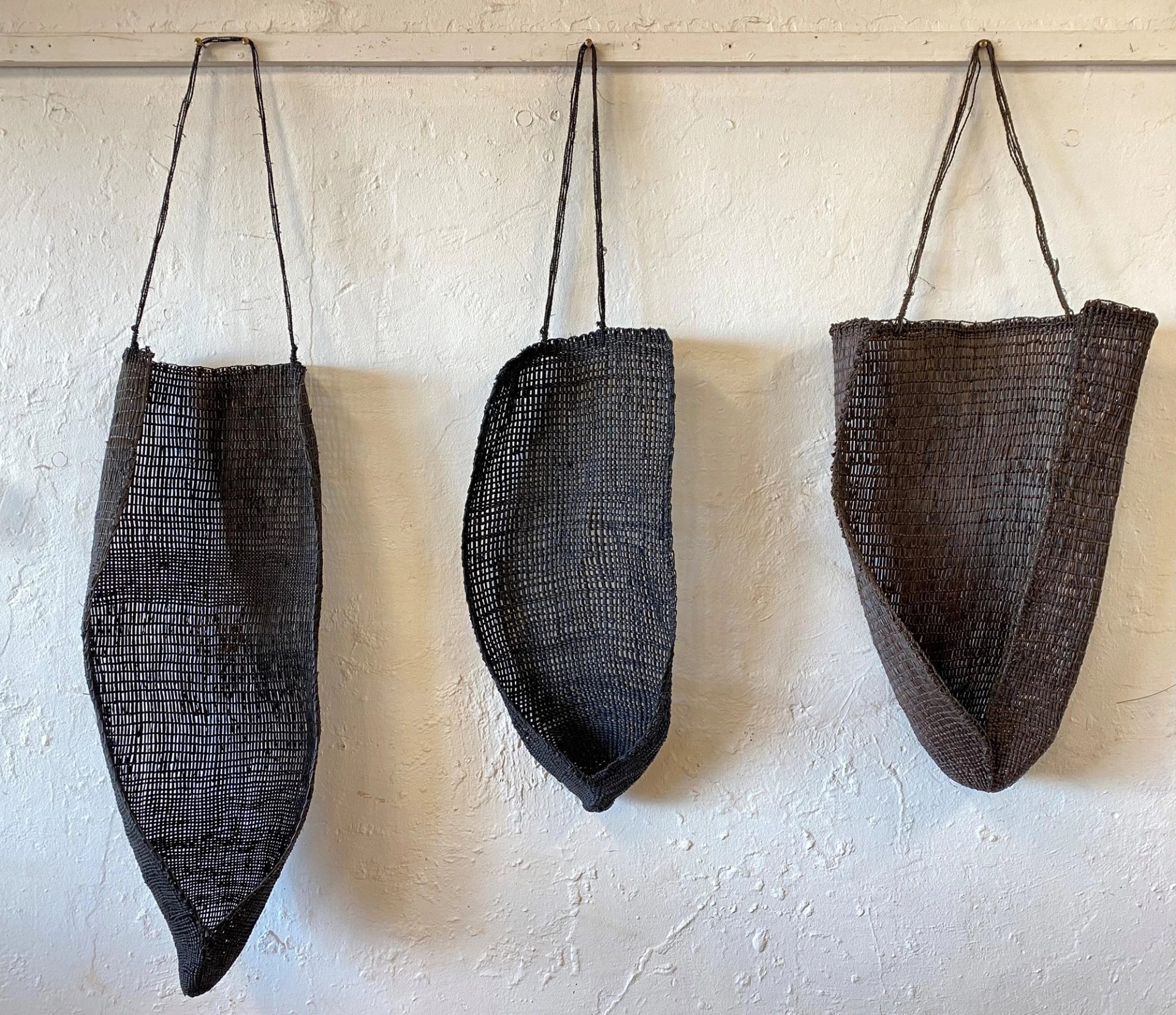
Helen is fantastic at conveying the meaning of her ganybu, Mandi recorded her story for us to share.
‘This is ganybu. People in Arnhem Land call it ganybu, from Miwatj area in the east to this area. Ganybu is the big name for everyone, but if we go west, Burarra people call it jaram. Here in Yurrwi (Milingimbi) and these islands, we call it mulutha. That’s the name for that pelican also, with the big neck. Maybe the old people got the idea from the pelican. They saw it catching too many fish with its big neck and maybe they were jealousing that pelican. So they said, “We’ll do it like that so we can catch those fish too."
Our old people, they used this fish net to hunt in swamps and rivers and creeks. When we see a billabong, we use it to catch garkuyi (blue-tailed mullet) and other little fish. Balanda (non-Indigenous people) use cast-net, we use mulutha (ganybu). I heard stories of mulutha when I was a young girl. So, when I saw those black and white photos of Old People using them, I knew it straight away. Then I saw one at the museum in Sydney and I thought, “I’ll make this ganybu." That was my idea. And I made it black. Mulutha has story too. It has ceremony. Song and dance – manikay. Even if it just looks like a fishing tool – no – it’s more than that.
I wanted to weave this so the next generation can see how clever our Old People are. How they could live in the bush – no Coca Cola or murtikar (car), they got everything from the bush to live. I want to weave this to show the next generation, just like my family showed me.’
Helen Ganalmirriwuy Garrawurra
The gay’wu string bags were completed too and again, were forms I hadn’t seen. They have flat bottoms made from conical pandanus and the body of the object is bush string in a knotting technique. Made from the inner bark of a local tree, this string is notoriously difficult to work with, it is rolled on the thigh. The knotting technique in these two works was based off the men’s fishing bag and is sturdy and abrasive to the touch. The fibre softens over time and use. I have one of the fishing bags at home. My mum made me use it as my school bag when my Billabong backpack split from the weight of my textbooks. The fishing bag didn’t break, but I felt embarrassed and poor. I wish I could tell that kid how rich she really was. I still have that bag.
Mandy and Elizabeth were generous and animated hosts, introducing us to everyone and showing us where everything was around the site. The men were making their way to the beach. Rarru was sipping tea out the front of her home. She doesn’t speak English, I don’t think she has to. Her gaze is strong and if you have any emotional intelligence or understanding of body language, you will pick up what she is communicating. The day was spent watching the ladies work and having short conversations. There was the usual question, ‘Where you from?’ Jacqueline Miyatatawuy, who is sitting processing the yellow root dyes, is married to one of the very few men who live out here. She lets me know she is Larrakia mob too. She calls me yapa (sister).
Hours later, the men were back. They had caught a turtle. Tim and I took up the invitation to go over and eat with yapa Jacqueline and her family. It was my first time eating turtle. I watched them prepare the food. I paid attention to the botanicals added for flavour and when offered small parts of each ‘dish’ I made an effort to try them all. Intestines. Meat. Soup. I kept my eyes firmly on yapa Jacqueline’s when drinking the soup, so as not to be put off by the colour or the floaties. When I got over the appearance and just tasted the flavours, I understood quickly that what I had in my hands was the tastiest and most favoured dish of this family. Ramen soup got nothing on that Laŋarra turtle soup. It was rich, thick and sweet. The kind of food you know is pumping with nutrition. The kind of soup that could bring you back to health after a bout of sickness. Jacqueline offered me the remaining soup. I had one more sip to confirm it as my favourite dish but I declined the rest, much to her kids' delight. It was downed by the kids in an instant. Tim and I made our way back to camp with yapa and the kids, leaving the men to cook the rest of their meals. The high grasses glowed yellow in the afternoon sun. Rarru asked me if I drank any turtle soup. The glint in her eyes told me she was happy that I tried it. The smile told me she was pleasantly surprised that I enjoyed it. Rarru had started on a new work in our absence. The sun would go down soon.
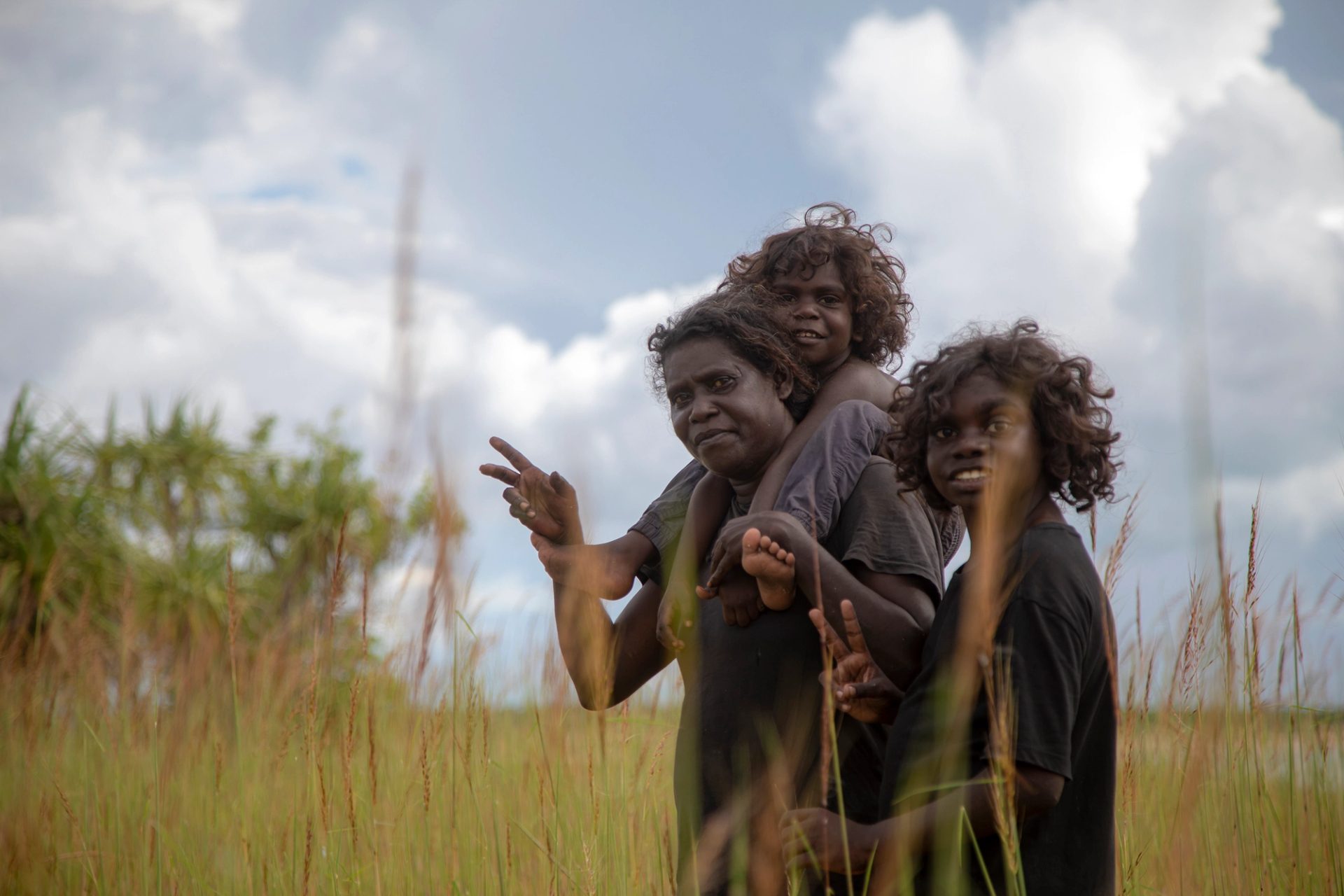
With the sun about to set, we set up camp. Four of us visitors laid out our camping gear in a line in the open shed. We grabbed firewood and lit fires all around us. We needed to keep them going throughout the night, they would keep the mosquitos, snakes, bulls, cows and pigs away. It was worth it for the stars – and a tent would have been suffocating in the heat, so this was the best option. We had frequent visits from our hosts each evening, checking in on us as we settled. Most nights we cooked veggies on the fire for dinner. Simple food. Everything tastes better cooked in a fire.
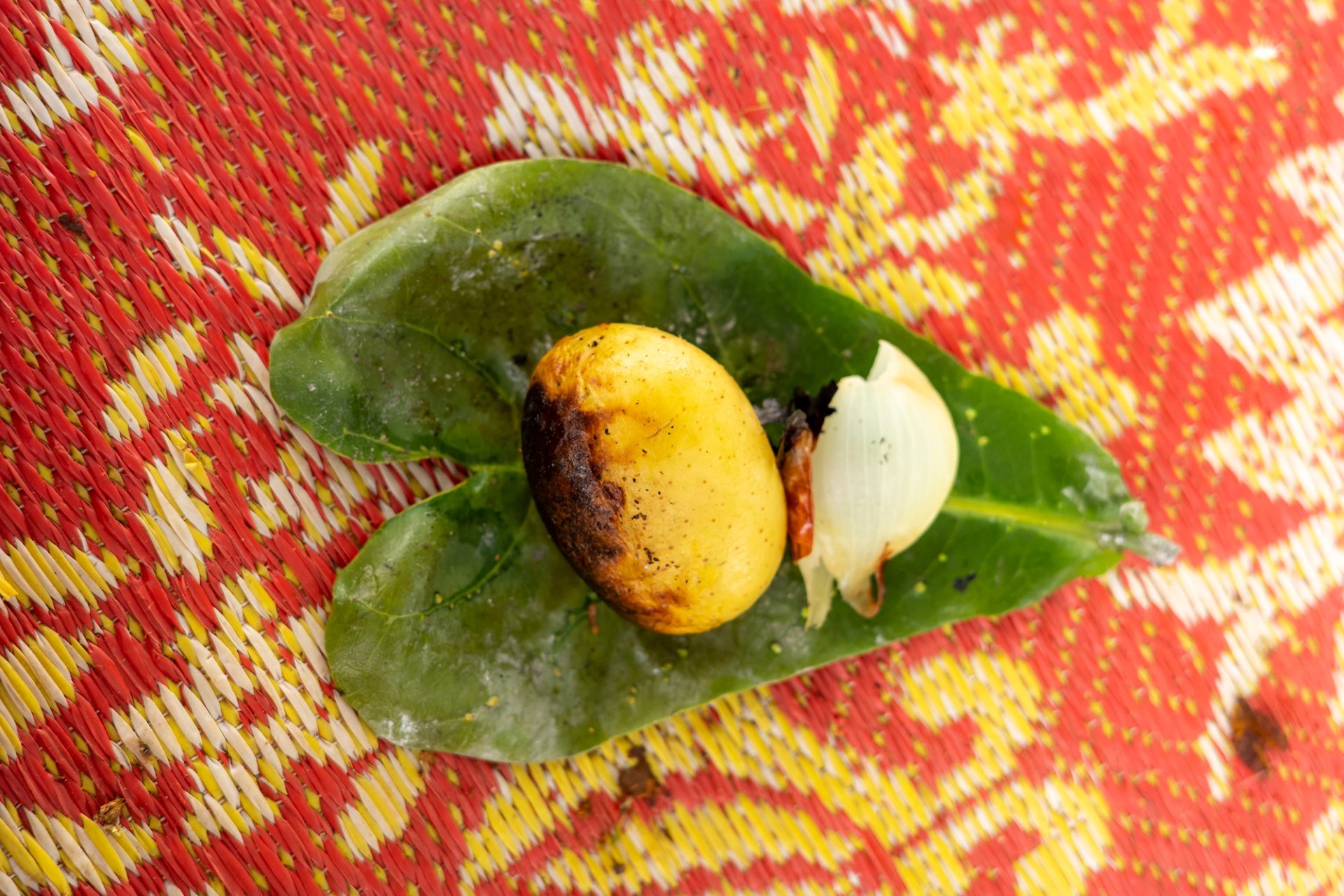

I fell in and out of sleep listening to Rarru and her family occasionally exchanging a word over the fire. A couple of them were still weaving into the early hours.
The shimmers of the pandanus whooshed in their hands and slapped on the ground. The firelight warmed my sweating body. I tried to fit under my sarong to cover my skin from the mozzies. I don't sleep much at night in any case.
The morning came and we conducted interviews after a cuppa. The day prior had gotten rid of most of the tension of meeting new people and the conversation was easy. I mostly left the women to talk about their work to each other. I didn’t want to be the next Leigh Sales with a microphone and direct lines of questioning. I just wanted them to talk about their work, their way.
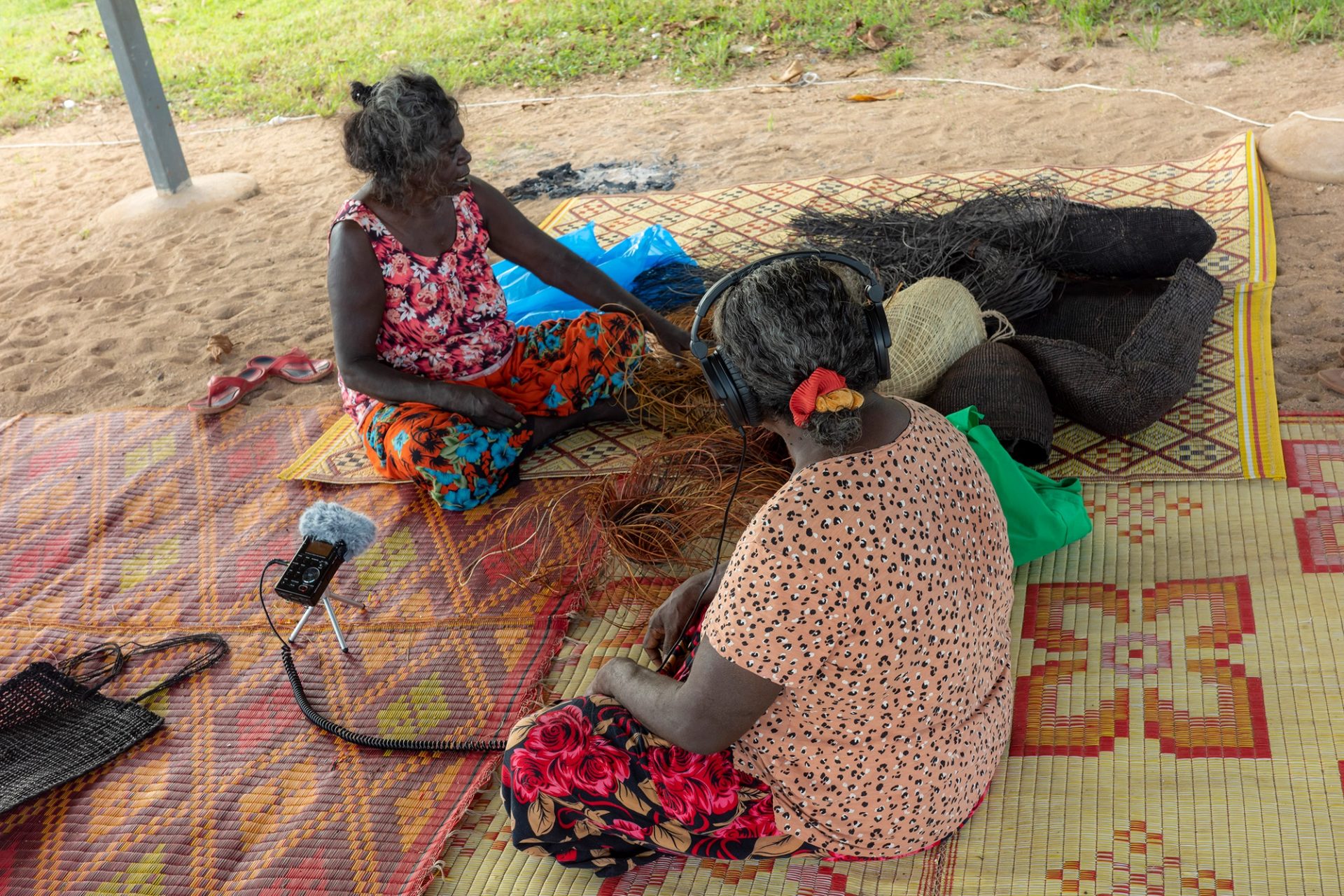
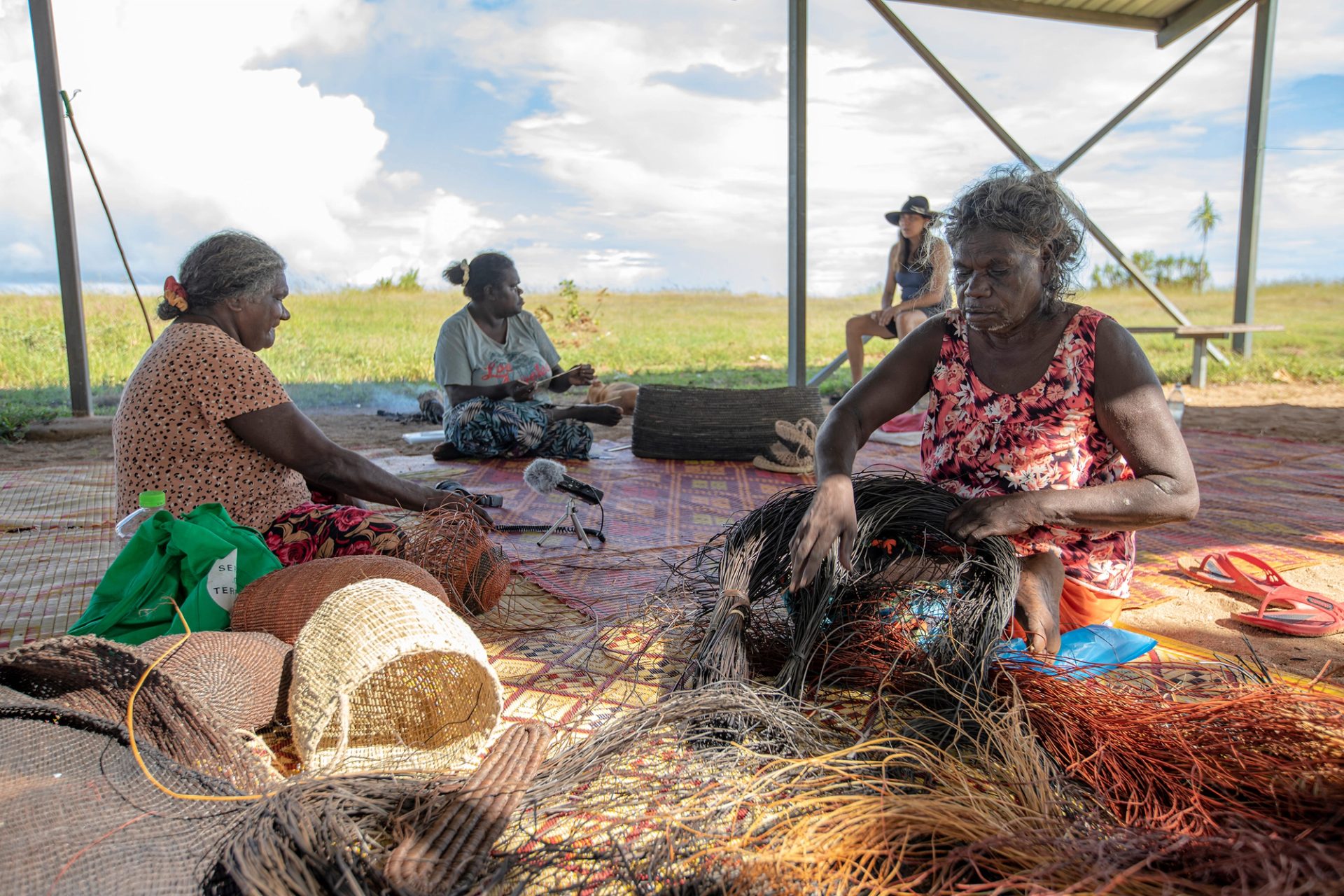
Helen told me about Rarru’s life. That she was the one to make the ceremonial objects. That’s her job, but I would never see any of those things she made. They were just for their people, private. What she had made for Alchemy was some of the miṉḏirr. I know this one from my own women, my own story. Miṉḏirr isn’t just a bag. It’s a sacred object. This was the first one, the first woven object. The Djan’kawu Sisters story that is synonymous with Garrawurra country, song and law is the law of this Country and miṉḏirr is one of those items of significance. Rarru, as a young woman, took well to weaving and was taught the stories and how to make all the items for these particular ceremonies.
Rarru is always there for this community, overseeing everything. It’s a calm place because of it. I could see that now that I have been here. I can see how they make these magic things.
Half the people jumped in a boat and headed to a neighbouring island for a funeral. Our day was quieter, more focused on weaving. I took a few walks along the beach with Miriam and we sat together side by side. Miriam was getting redder with sunburn as the days went on. This is not comfortable travel and even for me and Tim, who have been out bush plenty enough, it was a tough trip physically. The people you travel with can make or break a trip like this. I did see something change in Miriam over this trip. Originally from Sicily, she settled some time ago in Australia. This is her chosen home, and on this trip, I watched her choose Country. When she sat in silence and accepted the tough environment for what it was, something inside her grew. We laughed about it retrospectively, saying she felt like she underwent a form of transformation thanks to the isolation and physically demanding conditions. She did. She chose Country and not the thoughts in her head that could have made that trip one that broke her.
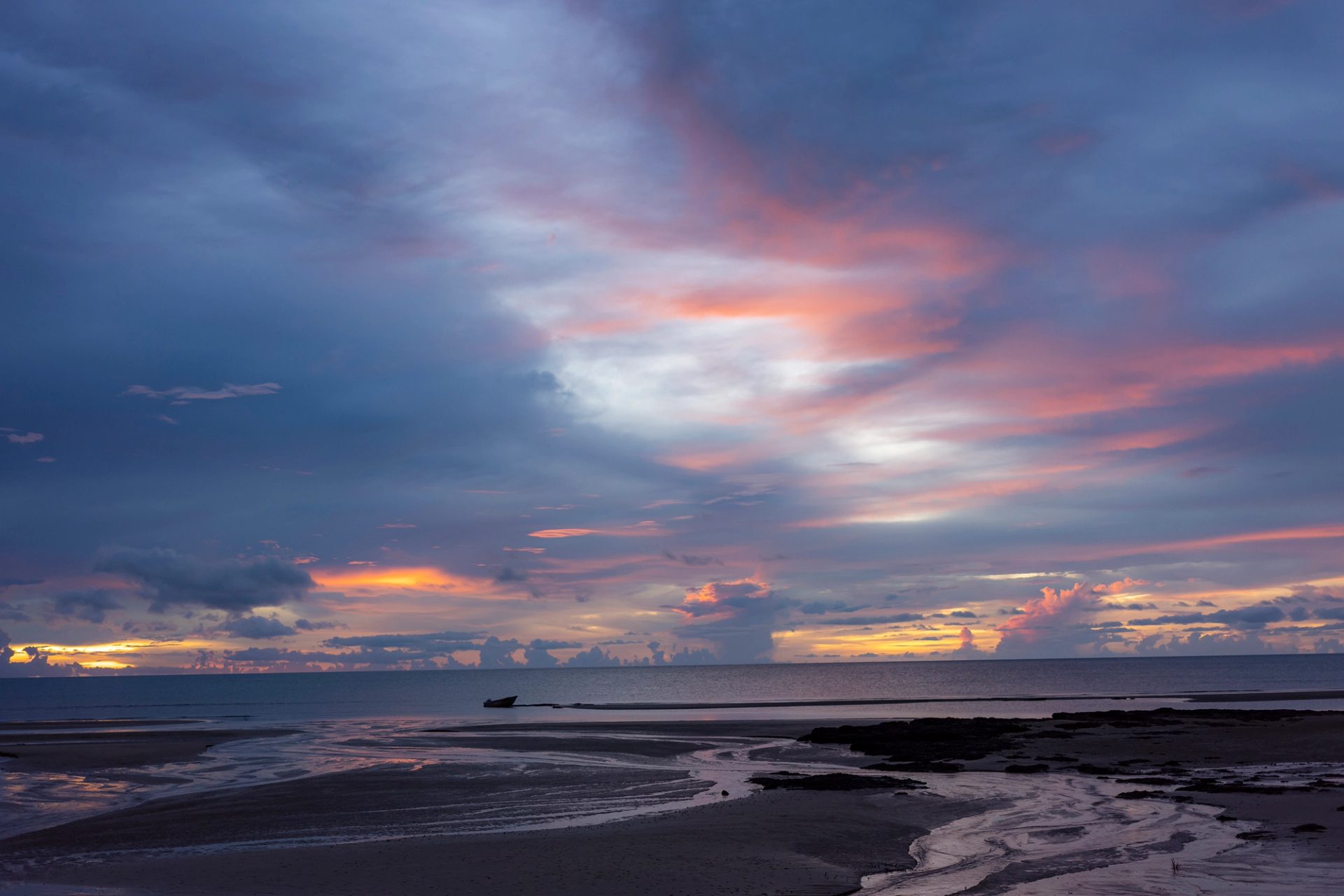
When night fell I wondered where the rest of the people were…and when would they be home. Space felt different there, there is so much of it. Far off in the distance the boat could be heard buzzing across the water. It took some time for the sound to get louder as they approached the beach. It felt like stepping back in time. No phone reception. No way to know when they would be home. Navigating their way home using the stars, bags full of groceries, they came home. Flashlights illuminated their paths and revealed their silhouettes, heavy bags in hand. Jacqueline came to our camp with a box of instant cappuccino sachets. A gift for the visitors! I could stop scabbing Tim’s fancy Melbourne coffee now. Tomorrow we would go to Marrawuddi Arts and Culture centre in Kakadu.
In the morning we said our goodbyes. The single engine plane arrived, and we packed our things into the wheelbarrow. But once packed and in our seats, the pilot told us to get out again. He had lost both fuel caps. We were ‘stranded’. The pilot called for help and sat with his tail between his legs for hours. Elizabeth kindly made us some damper under the tree. Thick and heavy, she handed us some peanut butter to smother over it. It was still warm, and the peanut butter dripped off the sides. Heavy enough to fill our bellies until help came. Comfort food, a generous gesture of care. I took some over to the pilot who appreciated the little bit of food. Seven hours later the rescue team arrived and made it a good memory for all involved. Mandi jumped on our original plane to Yurrwi, and we flew straight to Jabiru with our new pilot, Tom. The airstrip was closed after that flight. Deemed unsafe until it could be re-graded.
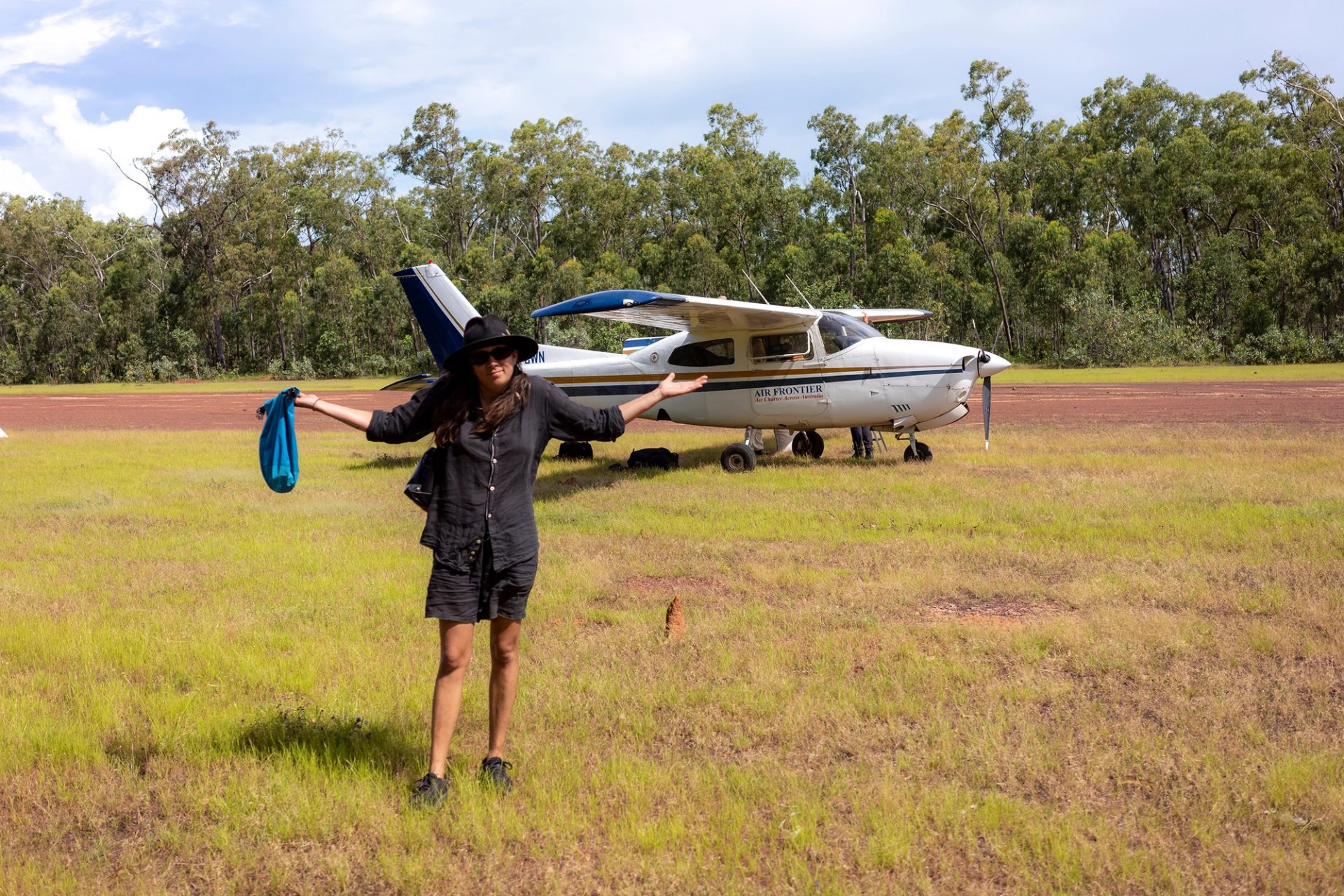
Contributing Artists
Margaret Rarru Garrawurra
Dhuwal
Margaret Rarru was born in Galiwin’ku (Elcho Island). Today she lives on her mother’s Country of Laŋarra (Howard Island) and at Yurrwi (Milingimbi Island), both off the coast of north-east Arnhem Land. In the unhurried environment of Laŋarra homeland, Rarru gathers materials and processes them into artworks, imbued with their ancestral origins and Rarru's drive to create new distinct forms.
In 2022, Rarru won the Telstra National Aboriginal and Torres Strait Islander Art Award (NATSIAA) for her Dhomala, a monumental three-metre tall handwoven pandanus sail. The work referenced the contact between Makassan seafarers and traders of the Indonesian Archipelago and saltwater peoples of northern Aboriginal nations.
Rarru is a senior artist and master weaver at Milingimbi Art and Culture, and a respected elder among the community. Rarru speaks little English, however she engages with the balanda (non-Indigenous) world through her art practice, becoming well known for her ‘Madonna bra’ bathi (baskets) and wearable pieces, as well as her minimalist forms including mol mindirr (black dillybags).
The technique of immersion dyeing has been widely practiced in Arnhem Land since the arrival of missionaries, however the recipe for creating black dye from local plants has been refined by Rarru. From blue to copper blacks, Rarru has become renowned for the depth and range of her black hues. Yolŋu weavers respect Rarru's commitment to her practice and while they may know the recipe and use small amounts of mol (black), the use of mol alone in a work is reserved for Rarru and those to whom she gives permission.
Helen Ganalmirriwuy Garrawurra
Dhuwal
Helen Ganalmirriwuy Garrawurra is a proud Ḻiyagawumirr Garrawurra woman. Ganalmirriwuy grew up on her mother's Country at Laŋarra. Her father's Country, Gärriyak, is on the mainland, south of Galiwin’ku and Laŋarra. Today Ganalmirriwuy lives and works at Milingimbi and Laŋarra. As a master weaver and painter, she is known for her limited palette inspired by Ḻiyagawumirr Garrawurra ceremonial body paint designs.
‘I am a Ḻiyagawumirr Garrawurra woman. And my maḏayin' are the two Djan'kawu. You know, the Two Sisters – the ancestral beings. They gave miku (red), watharr (white) and buthalak (yellow) ochre colours for us to paint with. We use them for the Ŋärra law ceremony, which is a cleansing ceremony.’
Ganalmirriwuy paints her clan designs onto ṉäku, lorrkun ga miṉḏirr (bark, hollow logs and woven dilly bags) as well as paper and board. The minimalist aesthetic that is inherent to her Ḻiyagawumirr Garrawurra clan designs also informs the colour fields and geometric patterns explored in her weavings.
Mandy Batjula Gaykamaŋu
Gupapuyŋu
Mandy Batjula Gaykamaŋu is a Gupapuyŋu woman, daughter of esteemed community leader, Helen Milminydjarrk. She lives and works alongside her mother and mother’s sisters, including senior artists Ruth Nalmakarra, Margaret Rarru and Helen Ganalmirriwuy.
In 2017 Margaret Rarru recognised Batjula’s commitment to her weaving practice and gave permission for her to create works using Rarru's own iconic black dye, which Batjula now pairs with her own distinctive coil technique.
The daily routine at Batjula and her mother’s camp is set by the rhythm of harvesting, preparing, dyeing and weaving bush fibres. She is a young artist, however the precision and detail of her work is of a standard usually attributed to the most senior weavers. In addition to her weaving practice, she also paints Garrawurra clan designs inspired by ceremonial body paint designs and sections of the Djan’kawu Sisters story synonymous with Garrawurra country, song and law.
Depending on the season and ceremonial obligation, Batjula divides her time between her grandmother’s homeland of Laŋarra and Yurrwi.











